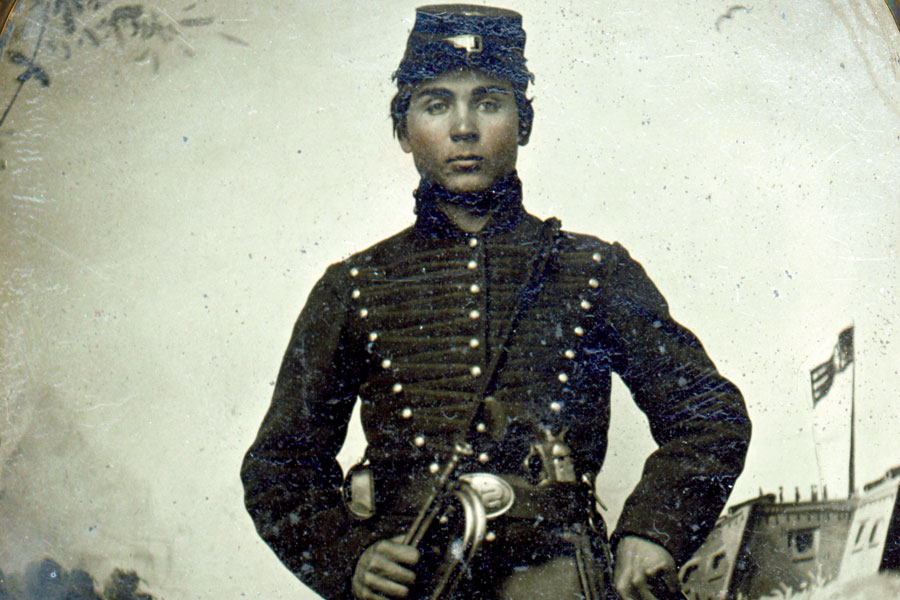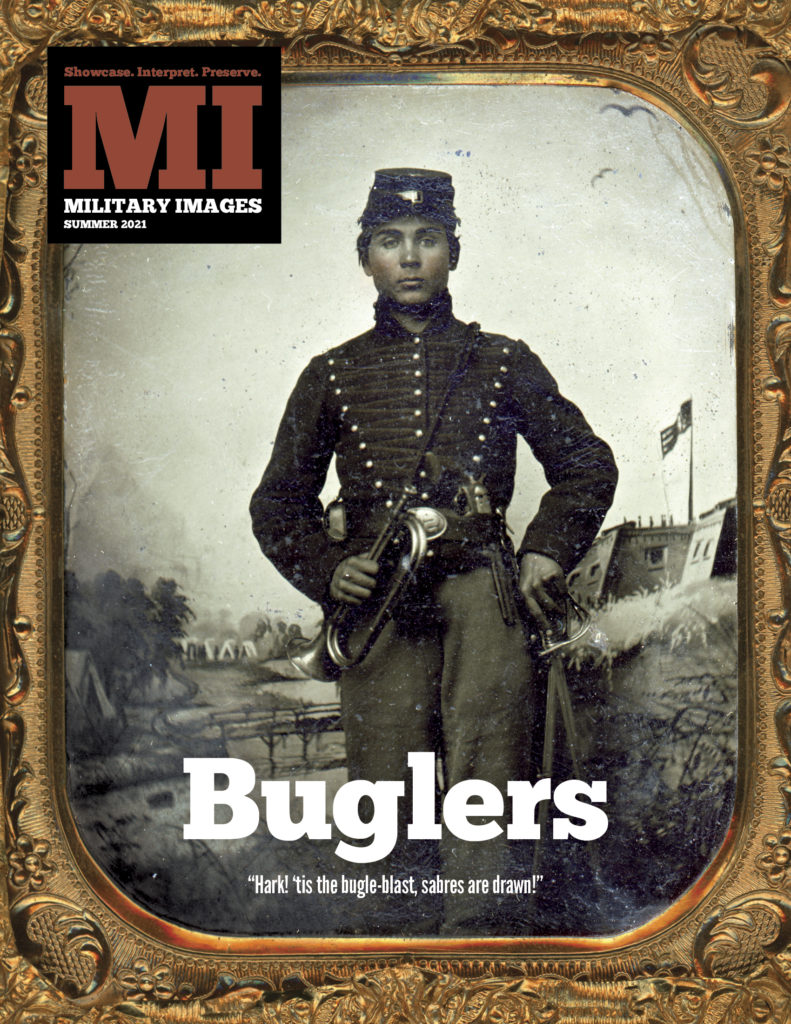The feature stories and columns you’ll find in our Autumn 2024 issue. Pick up a copy or a subscription in our store.
Finding Aid: Summer 2021
A complete table of contents for the Summer 2021 issue of Military Images magazine, and information about how to purchase single issues and subscriptions.
Vol. XXXIX, No. 3
(80 pages)
Print edition: Visit our store to check availability
Digital edition: Visit JSTOR.org to purchase
Subscribe to MI
Explore the MI Archives:
Browse | Advanced search | Tutorial
Inside
Cover image
A sixth-plate tintype from the Brian Boeve Collection pictures a musician with his bugle.
Table of Contents (p. 1)
Editor’s Desk (p. 2)
In “Musings on Showcasing,” the editor discusses the first word in the publication’s motto: Showcase. Interpret. Preserve.
Mail Call (pp. 3-4)
Feedback includes praise for RickWolfe’s profile of Everton and Seymour Conger, Jeremy Rowe’s story about “The Little Sack of Flower That Won the West,” Elizabeth Topping’s exploration of color in Civil War era photography, and more.
Military Anthropologist (p. 4)
A survey of newspapers from May through November 1863 reveals how many times the press referenced the Siege of Vicksburg and the Battle of Gettysburg.
Passing in Review (p. 6)
The three-volume Black Lives in Focus series by Ross J. Kelbaugh is reviewed: Part I: Colonial-Antebellum America, Part II: The Civil War & Reconstruction, and Part III: Jim Crow to Barack Obama.
Photo Sleuth by Kurt Luther (pp. 8-10)
In “Hampton’s Battery at Gettysburg and Puerto Rico,” Luther traces the backstory behind a post-war reunion photo taken at Gettysburg by W.H. Tipton. The image is unique due to the presence of Civil War veterans and National Guardsmen—all connected to Pittsburgh, Pa.
Antebellum Warriors (p. 12)
A quarter-plate ambrotype features a militia corporal with an artillery sword. The style of his uniforms asks more questions than it answers.
The Honored Few (p. 14)
Sgt. Maj. Herbert Elon Farnsworth of the 10th New York Cavalry received the Medal of Honor for volunteering to cross dangerous ground to stop a Union artillery battery from firing on its own troops—a case of friendly fire.
Most Hallowed Ground by Perry M. Frohne (p. 16)
Long before Capt. Emmet Crawford of the 3rd U.S. Cavalry was murdered while he chased Apache Chief Geronimo in Mexico, he served in the Civil War with the 71st Pennsylvania Infantry. He is buried in Arlington National Cemetery.
The Citizenry (p. 18)
In “Author of a Southern Anthem,” we meet James Ryder Randall of Baltimore, Md. In April 1861, he penned the poem “Maryland, My Maryland” after learning of the failure of pro-secession rioters to stop the 6th Massachusetts Infantry as it marched through his hometown. The poem was soon set to music and became a popular tune with Confederate soldiers and Southern citizens. It was the Maryland state song from 1939-2021.
Buglers (pp. 21-32)
A gallery of 31 images collected in collaboration with Editor Dale Niesen of the Facebook group “The Image Collector” and contributions by collectors, reviewed by Contributing Editor Chris Nelson, is focused on soldiers pictured with bugles and trumpets. All are Union musicians.
MMB: A concise history of the unconventional, untethered and unruly warriors of the Mississippi Marine Brigade by Paul Russinoff (pp. 34-42)
One of the Civil War’s most novel fighting forces, the Mississippi Marine Brigade, began its life as a fleet of rams, the brainchild of civil engineer Charles Ellet, Jr. After his death from an infected wound, command passed to his brother, Alfred, who built the MMB. This is its story.
The Compact: In 1864, a group of soldiers at an army hospital pondered their futures. They pledged to meet 20 years later to find out. By Ronald S. Coddington (pp. 44-54)
At the U.S.A. General Hospital in York, Pa., a dozen soldiers, including three hospital stewards, planned a reunion at Niagara Falls in 1884 to find out where life took them after the war ended. What happened to them, and the fate of the reunion, is revealed in this account.
“Lost an Arm in Freedom’s Fray” by Charles T. Joyce (pp. 55-62)
About 25,000 Union soldiers suffered amputations during the Civil War. These limbless men re-entered society, some faring well and others not. Here, we examine seven men who lost an arm as a result of the Battle of Gettysburg. Among them is artilleryman John F. Chase, who barely escaped when a canister charge exploded prematurely. Surgeons counted 48 shrapnel wounds on his body.
On the Art, Science and technology Behind the Modern Coloring of Images, a Q&A with Matt Loughrey of My Colorful Past (pp. 63-65)
“Coloring imagery is as old as photography itself,” notes Matt Loughrey, owner of My Colorful Past, a company that colorizes and adds motion to historic images. In this interview, he describes his process and how his work is rooted in research and history.
Marcus Aurelius Root Wrote a Photographer’s Handbook in 1864. It Includes 6 Tips That Can Help You Better Appreciate 19th Century Portraits. By Ronald S. Coddington (pp. 66-67)
Pioneer daguerreotypist Marcus A. Root believed photography was an art form, not purely a mechanical process. His handbook, The Camera, and the Pencil, makes the point in several ways, including these tips.
Participants in an Early Commemoration at Gettysburg’s National Cemetery? By Elizabeth A. Topping (pp. 68-70)
A carte de visite of a Union officer wearing a sash and two ladies dressed in Goddess of Liberty costumes taken by Gettysburg, Pa., photographer Levi H. Mumper is a clue to a little remembered event that took place on July 4, 1865.
The USCC at Camp Letterman by Elizabeth A. Topping (pp. 72-74)
A group of soldiers, men and women gathered at the United States Christian Commission station in Gettysburg, Pa., reveals details not previously explored. The station operated from July to November 1863.
Material Culture by Frank Graves (pp. 75)
In “Colt Model 1860 Army Revolver, early Fluted Cylinder,” Graves shares a tintype of a soldier holding the revolver, and provides details about its fluted cylinder, comparing it to the more popular rebated cylinder.
Behind the Backdrop: Origins, artistry and photographers by Adam Ochs Fleischer (pp. 76-77)
In “A Backdrop Connected to Portraits of Quantrill’s Men,” Fleischer examines the distinctive painted canvas with a vessel and ruins visible in two photographs by Thomas D. Saunders of Lexington, Mo. This background matches other images of men who served with William Quantrill’s raiders.
Stragglers: Distinctive Images from MI contributors (pp. 78-79)
Included are portraits of Brig. Gen. Alfred Jefferson Vaughan, Jr., who started the war as a captain in the 13th Tennessee Infantry and went on to suffer the loss of a leg during the Atlanta Campaign, and William G. Edwards of the 14th Mississippi Infantry, who suffered the amputation of an arm after at Spring Hill, Tenn., an action leading up to the Battle of Franklin.
The Last Shot (p. 80)
A quarter-plate ruby ambrotype pictures Pvt. James Lawrence Secrest of Mississippi’s Jeff Davis Legion of Cavalry. Secrest is seated on his horse, Sela.
Official Word on Magazine Mail Times
 A number of you have asked why your issue was taking so long to move through the mail system.
A number of you have asked why your issue was taking so long to move through the mail system.
According to the U.S. Post Office, the estimated time is 9-18 days—but all bets are off during the holidays, and when bad weather sets in.
You may recall the issues were sent bulk mail from Hanover, Pa., on Dec. 20, and at least two subscribers received their issue last Saturday, 24 business days after the mailing.
Thanks to Sheridan Press, the company that prints Military Images, I have a communication from the postal representative in Hanover. The representative details how an issue moves from the post office in Hanover to Arlington by truck to be processed for delivery:
All Periodicals that leave Hanover come here to Harrisburg P&DC – Processing and Distribution Center. The sack label then determines where the mail is transferred to from Harrisburg. If the mail is in a 5 Digit or 3 Digit sack the mail is then sent on transportation to the Distribution center for the zipcode on the sack label. If you are talking about Arlington VA 22205 – and the sack was labeled to either 5 Digit or 3 Digit Arlington – the mail would be loaded on a trailer to send to Southern MD 207. Then from their they would work the mail to go to Arlington 22205 and it would then go to the ADC/SCF office for zipcode 22205 which would be Northern VA 220. Here they would do the actual separation to Arlington and the mail would then go to Arlington to be delivered. The maximum time frame the mail can be held at each office is 3 days. Remember 1st class and Priority are worked first and then Periodicals and then Standard Mail.
So you would be looking at coming to Harrisburg could be held here for a maximum of 3 days then to Southern MD 207 for maximum 3 days – then to Northern VA 220 for a maximum of 3 days and then to Arlington VA for a maximum of 3 days – should be no more than 12 days from mailing until delivery. The standards are 9-18 days for Periodicals depending on where you are mailing to.
Now if the piece was in a MXD sack then you have to add from Harrisburg to (all mixed sacks from Harrisburg go to DV Daniels NJ to be processed) then you start the same process – which would be adding another 3 days until the time frame of 12 days for approximately 15 days. If the 1st class and priority volumes are light then the periodical mail will move faster – if the 1st class and priority mail volumes are heavy you can see the approximate 15 days for delivery.
The time frame you are looking at was over the Christmas Holiday which is the heaviest 1st class and priority time of the year this would then cause delays of the mail pieces. Also you have to take into consideration any weather related delays as this mail is trucked and does not fly. We have had terrible winter weather on the East Coast which also delays the mail delivery.




